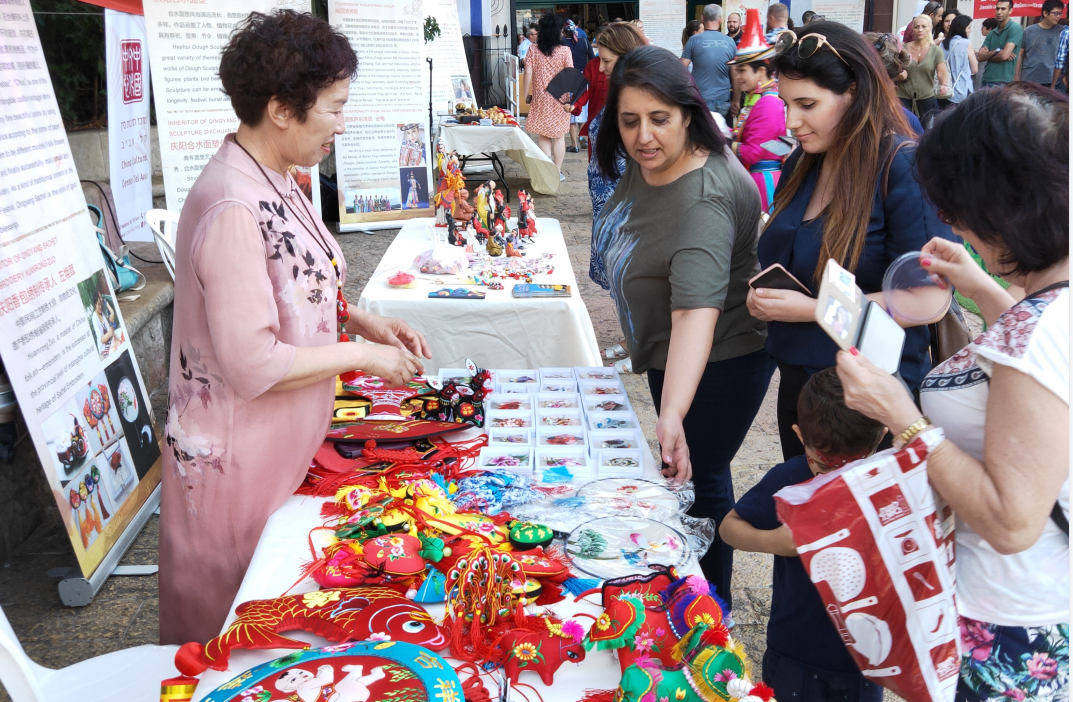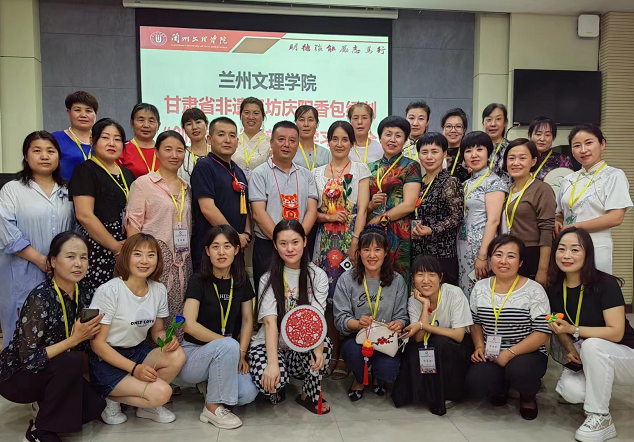Qingyang's location in the isolated Loess Plateau region hampered the sales and marketing efforts of its craftspeople and restricted the reach of their brands, however. It was necessary to consider how to best continue inheriting and innovating the thousands-of-years-old handicraft, expand its customer base in other parts of China and abroad, and help people who participate in the industry chain obtain a sense of satisfaction and fulfillment while increasing their incomes, especially rural women who produce sachets and embroidered items.

Foreign tourists shop for Qingyang scented sachets and other embroidered products at a folk culture festival.
Approaches and methodology:
Policies pertaining to areas such as targeted poverty alleviation and embroidery companies to establish manufacturing facilities in rural parts of Qingyang and create specified quantities of products in accordance with particular criteria since 2013. The city has forged a new path involving “specialized design teams, master crafts people powering production, tens of thousands of households participating, and leading enterprises engaging in marketing and sales,” and operations models such as “bases + companies,” “companies + rural residents,” “designers bringing rural residents along,” and “group exhibitions” have been implemented with regard to the development of folk culture industries, which has made it possible for participants to earn dignified incomes in their local areas and take care of their families.
Qingyang’s government has made efforts to promote the city’s intangible cultural heritage, including by launching the annual Scented Sachet and Embroidery Culture and Art Festival, which has been held 17 times since 2002. Enterprises engaged in manufacturing, sales, and marketing have participated in various art exhibitions and folk tourism festivals, which has helped sachets and other scented products become more popular both domestically and internationally.
A long tail business strategy in which relatively low volumes of niche and somewhat popular items are sold to many customers was implemented, and vertical markets have been tapped into, which has helped boost profits. Exhibitions and other traditional channels have helped with customer acquisition, especially with regard to distributors, while the internet makes it possible for scented sachet and embroidery companies to quickly reach a large number of consumers by way of online advertising, search engine optimization, and other approaches, including long tail customers who were previously difficult to locate. Cross border intellectual property cooperation, co-branded marketing, personalized customization, livestreaming, and other efforts have contributed to Qingyang’s scented sachets and embroidery becoming significantly more popular online, and the speed at which product iteration and innovation occur has accelerated markedly, which has resulted in sales expanding considerably.

Participants in a Qingyang scented sachet and embroidery training course themed on creative design at the Gansu Intangible Cultural Heritage Workshop pose for a photo at the completion of the event in July 2022. Fifty women exchanged knowledge and information and learned various skills and techniques over the 15-day course offered for free by the Lanzhou University of Arts and Sciences under the sponsorship of the Gansu Provincial Department of Culture and Tourism.
Actions:
● A relatively complete working system designed to support the inheritance and protection of intangible cultural heritage was created.
● Qingyang’s government established a standardized support system for intangible cultural heritage inheritors at the municipal, provincial, and national levels under the supervision of higher level government bodies.
● The Gansu Provincial Government sponsored a free training course themed on creative design in Qingyang in July 2022. Fifty women learned various skills and techniques and exchanged knowledge and information over the 15-day course, which helped improve the quality of their output and their ability to design new products.
● Emphasis has been placed on R&D and innovation, and efforts have been made to expand usage scenarios and the scented sachet and embroidery consumer base.
● The Qingyang government established an organization known as the Scented Sachet Folk Culture Research Center. Practical embroidered items that cleverly combine tradition with fashionable modern elements.
● The division of labor has been refined, and the production process has become more flexible, which has resulted in more employment opportunities in rural parts of Qingyang. The women who reside in the city have passed down traditional scented sachet and embroidery skills and techniques from one generation to the next over the millennia, but a narrow range of products were produced by small-scale manual workshops with limited access to market information and mostly sold by street vendors before efforts were made to develop the industry.
Results:
● A tiered talent system dedicated to the inheritance of scented sachet and embroidery skills and techniques was established, and a characteristic local industry gradually emerged.
● One national level scented sachet and embroidery inheritor, 4 provincial-level inheritors, and 23 municipal-level inheritors had been designated in Qingyang as of summer 2022, and more than 190 sachet and embroidery folk culture companies produced a total of over 9 million pieces of 5,000 types of products in more than 20 categories in the city in 2021.
● The industry has enabled nearly 100,000 rural women to work in their local areas and made it possible for them to increase their average annual incomes from around 5,000 yuan (US$746) to 20,000 yuan (US$2,985).
Lessons learned:
● Systems and technologies can support and strengthen intangible cultural heritage handicrafts and help balance development and protection. Raw materials, skills and techniques, and styles associated with intangible cultural heritage handicrafts constitute their unique economic moats. Laws, regulations, and protection systems related to intangible cultural heritage can significantly improve product recognition and social awareness of related handicrafts and help lay a solid foundation for conservation and development of such heritage. Policies issued and guidance provided by the government as well as the introduction of practitioners’ latest concepts and state-of-the-art production technologies can significantly improve productivity while retaining tradition and inject new momentum into handicraft industries.
● It is important to effectively integrate with the market while inheriting and rejuvenating intangible cultural heritage. Linking protection of in-tangible cultural heritage with commercial production can help traditional handicrafts and other creations integrate into modern society and people’s daily lives, benefit the public, and inject vigor and vitality into the conservation and development of intangible cultural heritage. Artists, designers, and craftspeople should cooperate and utilize mature market operation systems in the process of commercial production in order to transform intangible cultural heritage into creative products with high added value so that in-tangible cultural heritage can effectively enter the market.
● The internet can play an important role in traditional handicraft sales.Traditional handicrafts are often produced on a smaller scale and at slightly higher cost than industrial products as a result of the unique culture and aesthetics associated with them, which can be a natural disadvantage when targeting the public through traditional mass consumption channels. The popularity of e-commerce and the internet in general has resulted in the creation of a large number of vertical markets, however, resulting in new spaces that enable higher gross profit for traditional handicrafts with smaller production scale.
Related Link:
Qingyang Scented Sachets: Inheritor Brings Bread to Life
http://www.wfpchinacoe.net/2023-01/05/content_85040989.shtml
Category
Qingyang Scented Sachets: Ancient Handicraft Becomes Modern Industry
Contributor
Qingyang Scented Sachets: Ancient Handicraft Becomes Modern Industry
Country
Case Study

